By Alex Trukan
One of the main FC Barcelona characteristics is patient build up from the back. Passing the ball out from a goalkeeper and then progressively playing through the thirds up to the opposition goal is not only nice to watch but also effective. FC Barcelona players have been doing it for years and obviously got comfortable under pressure and in tight areas. This has got them a lot of success and high ball retention statistics they are known for. Many teams have attempted to disturb their style of play, force mistakes and regain possession. Only couple of teams, however, caused a real problem and prevented FCB from effective playing out from the back. If the opposition is successful, this can lead to a more direct style of play and more long passes being used by Barcelona, what might be an advantage for the opposition. This article presents one of the defending strategies used by Atletico Bilbao, which might help in stopping FC Barcelona from patient build up from the back and force them into committing more mistakes and losing possession.
When a goalkeeper is in possession of the ball, two strikers should stay in one line and get into positions which allow them to press centre backs as the ball is played out. At the same time, their position should stop the goalkeeper from making the first pass into defensive midfielder. If there is a preference for opposition building up through specific centre back, shape of the front two strikers should reflect that (forcing/stopping). Both strikers should move torgether and stay within supporting distance.
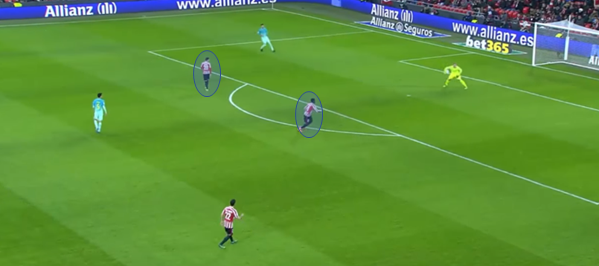
If a goalkeeper is in possession and the ball is in play, one of the strikers should make a curved run to press the ball from one side. This will cut off one centre back and make the play more predictable. At the same time, it will put the goalkeeper under pressure to make a decision and possibly play long. Second striker will adjust his position to be able to press the second centre back (open). Offensive midfielder should come higher and get tight with opposition defensive midfielder.
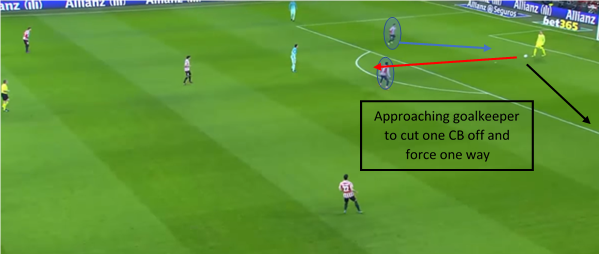
As soon as the ball is passed into one of the centre backs, urgent and aggressive pressure should be applied on him. Nearest striker curves his run to reduce options to play backwards and denies the space available for centre back in possession. Second striker comes across and supports. At the latter stages of pressing (when player in possession has his head down), second striker might choose to cut the option back to the goalkeeper – don’t start this too early as the ball will be then switched to the second centre back. Offensive midfielder follows defensive midfielder and man marks him. Second centre back is left free as he is not an immediate danger.
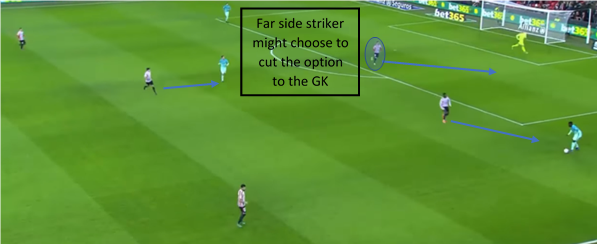
One of the solutions opposition might try is to have number 8 and 10 coming deeper into own half and trying to get the ball. These players should be followed tightly by defending team centre midfielders. Priority is to prevent them from turning and playing forwards.
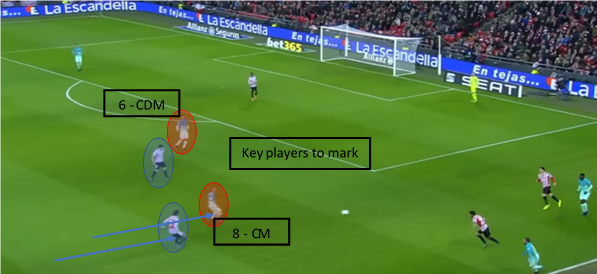
The only available option for the opposition might be a long ball from centre backs or goalkeeper into full backs. This type of pass, however, allows defending team’s full back to get tight and deal with it. It is important that central midfielders stay centrally and let full back deal with this type of pass. This will ensure that central areas are protected and second balls not picked up by opposition midfielders. As full back is dealing with a long pass, centre backs should come across and offer support.
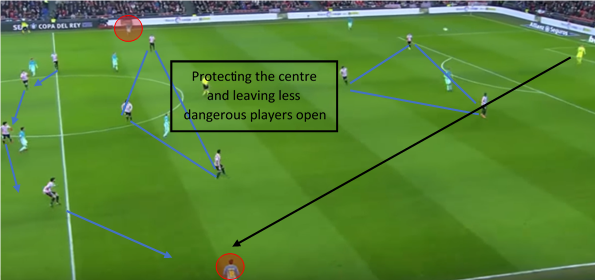
At some point during the game, the team will play out from the defensive third and establish possession in a back line. To prevent them from playing further forwards, it is important to recognise triggers to press. One of the triggers in a more offensive variant is when the ball is switched across the centre backs. As soon as the pass is released, the nearest striker makes a curved run to press the receiving centre back. Second striker has to either deal with second centre back (more offensive option, one of the midfielders will have to mark defensive midfielder) or opposition defensive midfielder (more balanced option, if offensive midfielder stays in flat line and leaves opposition defensive midfielder open). The rest of the team stays compact and moves together as the ball moves.
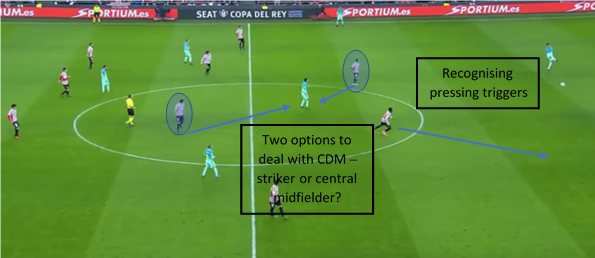
When dealing with a team that plays out from the back and trying to force them into more direct style, centre backs should be prepared to deal with long passes. These should be anticipated (based on body position and runs off the ball) and additional space allowed to cover spaces in behind the back line. Goalkeeper’s position will be also affected as he will now play higher up the pitch reducing the gap between the goal and the back line.
By Alex Trukan, Development Coach, Nottingham Forest
@AlexTrukan


